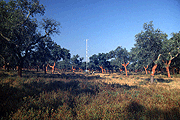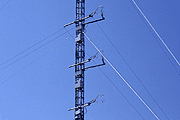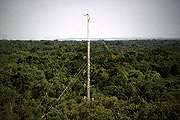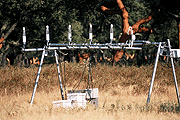 |
The knowledge on turbulent exchange above rough surfaces becomes increasingly important, because attempts are made to model dispersion processes close to forests or cities. There is especially a lack of knowledge on turbulence characteristics in canopies of sparse and indermediate density. | ||
 |
The data from the Rio Frio Tower provides vertically high resoluted information on turbulent exchange mechanisms within and above such a sparse canopy. The setup is designed for the study of vertical divergences of sensible heat, CO2 and H2O fluxes. | ||
 |
The 20m high triangular lattice tower supported 9 ultrasonic anemometers (CSI CSAT3) and 5 CO2/H2O open path analyzers (LICOR 7500). All raw data was synchronously dumped to an industrial computer and a datalogger. | ||
 |
Just around tree top the vertical resolution of the measurements were enhanced. This is the region, where highest gradients were supposed to be measured. | ||
 |
Prior to the tower measurements, all open path analyzers had been intercompared.< BACK |
2004 Photos by Andreas Christen, Institute of Meteorology, Climatology and Remote Sensing, University of Basel